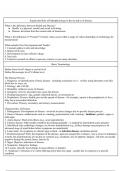Class notes
Class notes PNP (PNP320) Study Guide for Gould's Pathophysiology for the Health Professions
- Course
- PNP (PNP320)
Class notes for practical nursing pathophysiology week 1 - contains stroke (ischemic and hemorrhagic), TIA, Inflammation, Infection
[Show more]



